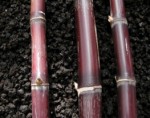Scientific Name: Saccharum officinarum
Polynesian Introduced: All HI
Description: There are many varieties or cultivars of Ko that were developed by Hawaiians. Generally, they are large grasses with hard stems (stalks) and long blades. This plant can reach heights of up to 15 feet tall. Its most attractive feature is its stalk, which range in color from light yellow (Ko Kea) to dark red (Ko Honua Ula). Many varieties have different striped combinations like maroon and green (Ko Manulele) or yellow pink and green (Ko Halali’i), all of which are very striking.
Varieties of Hawaiian sugar cane were hybridized with introduced ones to produce the type that was grown commerically here. Plantations started in the early 1800s, when people came from all over the world to work in them, resulting in the Hawaii’s diversity.
Distribution:Ko was brought to Hawaii by early Polynesian settlers and is termed a Polynesian introduction. It originates in southern Asia or Malaysia. In Hawaii, many varieties were cultivated on all the islands, but today they mainly exist in botanical gardens.
Landscape use and care:Ko thrives best in full sun and daily watering is recommended but not necessary. Due to its appearance, Ko is a great accent plant for any garden, the Ko variety Honua’ula stands out especially because of its dark red stalk and leaf blades.
Cultural uses:Ko has many uses in Hawaiian culture, most importantly as a sweetener. Juice was extracted from the fibrous stalk and used to sweeten dessert puddings and to make medicines more palatable. Children were also encouraged to chew the sweet stalk to strengthen their teeth and gums.
The juice of certain varieties were used as a love potion to induce the love of another person, while other varieties were used to block that love spell.
The blades were also used for house thatching when the more preferred pili grass was not available.
Ko

